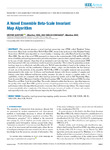Mostrar o rexistro simple do ítem
A novel ensemble Beta-scale invariant map algorithm
| dc.contributor.author | Quintián, Héctor | |
| dc.contributor.author | Corchado, Emilio | |
| dc.date.accessioned | 2020-08-10T10:44:59Z | |
| dc.date.available | 2020-08-10T10:44:59Z | |
| dc.date.issued | 2020-06-11 | |
| dc.identifier.citation | H. Quintián and E. Corchado, "A Novel Ensemble Beta-Scale Invariant Map Algorithm," in IEEE Access, vol. 8, pp. 108857-108884, 2020, doi: 10.1109/ACCESS.2020.3001690. | es_ES |
| dc.identifier.issn | 2169-3536 | |
| dc.identifier.uri | http://hdl.handle.net/2183/26122 | |
| dc.description.abstract | [Abstract]: This research presents a novel topology preserving map (TPM) called Weighted Voting Supervision -Beta-Scale Invariant Map (WeVoS-Beta-SIM), based on the application of the Weighted Voting Supervision (WeVoS) meta-algorithm to a novel family of learning rules called Beta-Scale Invariant Map (Beta-SIM). The aim of the novel TPM presented is to improve the original models (SIM and Beta-SIM) in terms of stability and topology preservation and at the same time to preserve their original features, especially in the case of radial datasets, where they all are designed to perform their best. These scale invariant TPM have been proved with very satisfactory results in previous researches. This is done by generating accurate topology maps in an effectively and efficiently way. WeVoS meta-algorithm is based on the training of an ensemble of networks and the combination of them to obtain a single one that includes the best features of each one of the networks in the ensemble. WeVoS-Beta-SIM is thoroughly analyzed and successfully demonstrated in this study over 14 diverse real benchmark datasets with diverse number of samples and features, using three different well-known quality measures. In order to present a complete study of its capabilities, results are compared with other topology preserving models such as Self Organizing Maps, Scale Invariant Map, Maximum Likelihood Hebbian Learning-SIM, Visualization Induced SOM, Growing Neural Gas and Beta- Scale Invariant Map. The results obtained confirm that the novel algorithm improves the quality of the single Beta-SIM algorithm in terms of topology preservation and stability without losing performance (where this algorithm has proved to overcome other well-known algorithms). This improvement is more remarkable when complexity of the datasets increases, in terms of number of features and samples and especially in the case of radial datasets improving the Topographic Error. | es_ES |
| dc.language.iso | eng | es_ES |
| dc.publisher | Institute of Electrical and Electronics Engineers Inc. | es_ES |
| dc.relation.uri | https://doi.org/10.1109/ACCESS.2020.3001690 | es_ES |
| dc.rights | Creative Commons License Attribution 4.0 International (CC BY 4.0) | es_ES |
| dc.rights.uri | http://creativecommons.org/licenses/by/4.0/es/ | * |
| dc.subject | Ensembles | es_ES |
| dc.subject | Topology preserving mapping | es_ES |
| dc.subject | Quality measures | es_ES |
| dc.subject | SOM | es_ES |
| dc.subject | SIM | es_ES |
| dc.subject | ViSOM | es_ES |
| dc.subject | MLHL-SIM | es_ES |
| dc.subject | GNG | es_ES |
| dc.subject | Beta-SIM | es_ES |
| dc.subject | WeVoS | es_ES |
| dc.title | A novel ensemble Beta-scale invariant map algorithm | es_ES |
| dc.type | info:eu-repo/semantics/article | es_ES |
| dc.rights.access | info:eu-repo/semantics/openAccess | es_ES |
| UDC.journalTitle | IEEE Access | es_ES |
| UDC.volume | 8 | es_ES |
| UDC.startPage | 108857 | es_ES |
| UDC.endPage | 108884 | es_ES |
| dc.identifier.doi | https://doi.org/10.1109/ACCESS.2020.3001690 |
Ficheiros no ítem
Este ítem aparece na(s) seguinte(s) colección(s)
-
GI-CTC - Artigos [84]






